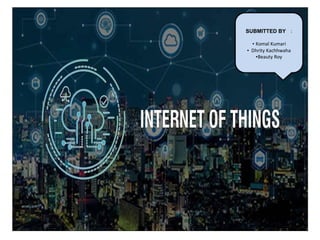
Iot ppt
- 1. SUBMITTED BY : • Komal Kumari • Dhrity Kachhwaha •Beauty Roy
- 3. The term “Internet of Things” refers to all those objects or devices of everyday life that are connected to the Internet and that have some kind of intelligence.
- 4. HISTORY OF IOT • The internet isn’t that old, so far as the world wide web. In 1974, the TCIP/IP structure that we know today had it’s birth. It was not until ten years later that the first domain name system or DNS was introduced. The first website actually came online in 1991. The internet that he had proposed just a scant two years earlier came crashing into our mainstream world. In no time the internet took over. By 1995, multiple websites and systems came online • The concept of the internet of Things first became popular in 1999, through the auto-ID centre at MIT and related market analysis publications . • 2008-2009: The Internet of Things was "Born“, • According to Cisco Internet Business Solutions Group (IBSG), the Internet of Things was born in between 2008 and 2009 at simply the point in time when more “things or objects” were connected to the Internet than people. • Citing the growth of smart phones, tablet PCs, etc the number of devices connected to the Internet was brought to 12.5 billion in 2010 (Related: see Kevin Kelly's One Machine), while the world’s human population increased to 6.8 billion, making the number of connected devices per person more than 1 (1.84 to be exact) for the first time in history.
- 5. • Devices and objects with built in sensors are connected to an Internet of Things platform, which integrates data from the different devices and applies analytics to share the most valuable information with applications built to address specific needs. • These powerful IoT platforms can pinpoint exactly what information is useful and what can safely be ignored. This information can be used to detect patterns, make recommendations, and detect possible problems before they occur. • For example, if I own a car manufacturing business, I might want to know which optional components (leather seats or alloy wheels, for example) are the most popular. Using Internet of Things technology, I can: • Use sensors to detect which areas in a showroom are the most popular, and where customers linger longest; • Drill down into the available sales data to identify which components are selling fastest;
- 6. • Automatically align sales data with supply, so that popular items don’t go out of stock. • Now that we all understand the IoT concept, it would be worthwhile to deep dive in order to get familiar with the building blocks of IoT:
- 9. • Iot platform can help organisations to reduce cost through improved process efficiency , assets utilisations and productivity. With improved tracking of devices/objects using sensors and connectivity, they can benefit from realtime insights and analytics, which would help them make smarter decisions. The growth and convergence of data, processes and things on the internet would make such connections more relevant and important, creating more opportunities for people, businesses and industries.
- 11. ECONOMIC ASPECTS OF IOT
- 14. IOT SECURITY • IoT is transforming entire industries, creating tremendous benefits but also introducing new risks. • The security risks surrounding IoT software and applications are snowballing as developers are pressured to get devices either to the marketplace or into use within an enterprise as soon as possible. As billions of devices become connected to IoT, security solutions enable their safe and reliable operation. • With over twenty years as a leader in software security, we are uniquely positioned to adapt and apply software Security best practices to your IoT
- 15. development initiative, or to help you assess your risk exposure to IoT products within your business. SOLUTION 4 steps to a successful IoT security solution Our goal is to help you deliver a sustainable IoT security initiative that provides continuous and comprehensive security risk identification and mitigation. We do this by empowering you to: 1. Integrate security into every aspect of your SDLC.
- 16. • 2. Educate your developers. • 3. Implement penetration testing. • 4. Perform threat modelling. CONCLUSION • Hence, today we learned how IoT works and an entire IOT system functions. Also, we discussed some real-life examples where we can use IoT. We will be learning more about IOT in detail in the upcoming tutorials. Till stay tuned to learn more interesting things.
- 17. Furthermore, if you have any query, feel free to ask in the comment section.